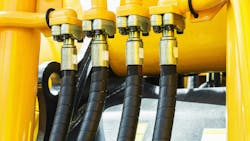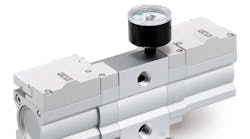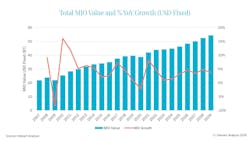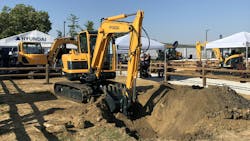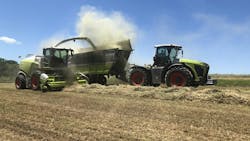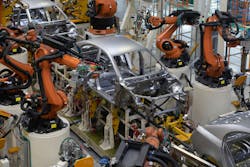Economic Signals are Improving for Fluid Power Industry in 2025
As we approach the end of 2024, there are signs of brighter days ahead in 2025 and 2026. This should be good news for the fluid power industry and its various customer markets, many of which faced a more challenging year in 2024.
High interest rates and inventory levels curbed demand for machines, and thus the components used within them, leading to a down market for many sectors in 2024. Tim LaCrosse, Business Development & Application Engineering Manager at Parker Hannifin, said in an interview with Power & Motion that the company was still contending with backlogs at the beginning of the year caused by the high levels of demand brought on during the COVID pandemic. However, these have begun to normalize.
Andy Thedjoprasetyono, Manager, New Product Marketing at SMC. Corp., said a resurgence in new orders is expected in the coming year as customer inventories finally begin to be consumed.
This anticipated normalization of inventories is one of the many indicators of improving market conditions for the hydraulics and pneumatics industry going forward.
Read our 2024 State of the Industry interviews with LaCrosse, Thedjoprasetyono and other leaders from the fluid power industry to hear their insights on current and future market conditions.
“Macroeconomic signals are picking up,” said Lauren Saidel-Baker, CFA, an economist at ITR Economics, during the National Fluid Power Association’s (NFPA) fall economic webinar. “2025 and 2026 is when the resurgence is happening. Leading indicators almost universally are showing signs of life.”
She said that by year-end and early 2025, shipments for both hydraulics and pneumatics should return to positive territory. This will be aided by a return to growth in several of the fluid power industry’s customer markets.
Growth Drivers for the Fluid Power Industry in 2025
According to Saidel-Baker, the industrial economy began to plateau in summer 2023 and has essentially been flat since then. By 2025 though it should begin to rise again; compelling leading indicators such as capacity utilization rates and purchasing managers indices are signaling its upward momentum. “We’re finally getting out of this latency environment,” she said.
Growth of 1.4% and 1.5% is expected over the next 2 years although it will not be symmetric across the board and across industries as there will be softness in some markets like construction which will be a mix of more positive momentum from the residential side of things but downside pressures in non-residential.
Meanwhile, sectors benefiting from federal government investment, such as computers and electronics due to the CHIPS Act — which also has consumer spending to help it — will fare better in the coming year.
Industrial machinery has experienced a deeper recession in 2024, but ITR is starting to see growth emerge for this sector and there are good signs for a rise in new orders in 2025. She said the overall CapEx (capital expenditures) cycle is supportive of this return to growth. Total CapEx spending is the highest it has ever been in history and heading into 2025 cuts in interest rates are expected to spur more spending activity.
The most recent Manufacturing Industry Output (MIO) Tracker from research firm Interact Analysis indicates recovery for the manufacturing industry as well in 2025 although it may be weaker than initially projected. It said the slowdown in this sector has been stickier for some markets and regions which could continue into 2025. But by 2026 it expects the manufacturing industry to return to normal.
Potential Recovery for Construction and Agricultural Equipment Markets
The heavy-duty off-road equipment industry remains a key customer segment for hydraulics and pneumatics, with construction and agricultural machinery being two of its largest customer markets.
Saidel-Baker said the U.S. Agriculture, Construction and Mining Machinery Production Index is currently showing a tentative recovery happening for both construction and agricultural machinery. She noted both markets are still below the year-ago level but are starting to show some signs of positivity again, which should bode well for the fluid power sector.
Mining machinery, however, remains in recession.
Construction Equipment
Construction will be a bit of a mixed bag with some growth in residential construction but slight decline in non-residential construction. Currently there are strong affordability constraints limiting new housing starts. However, housing starts are up 13% from the year-ago level as high interest rates were having a depressive effect on both new and existing home sales.
Low inventories still exist, but affordability is getting better as the income gap – the difference between what people should be making to afford a mortgage and what they’re actually making – is improving although not in a linear fashion, she said. Though not true for all in the U.S. population, in general, consumers are earning more which is helping to improve housing starts. She does expect lingering affordability constraints to dampen future growth for residential construction, but growth is expected for this segment.
Non-residential construction tends to lag behind the economic cycle, including residential construction by about 2 years. Spending in this portion of the construction industry is up 7% from the year-ago level but slow growth is expected to continue for the rest of the year said Saidel-Baker.
Ken Baker, CEO of Bailey Group, said in an interview with Power & Motion that non-residential construction has been a bright spot for the hydraulics industry in 2024. He also noted that year-over-year growth is starting to slow in this sector.
With the slowing growth, Saidel-Baker said a mild decline is expected by 2025. Aspects such as interest rates, which have yet to hit the market because it lags behind many other leading indicators, will be a factor as well as lower occupancy rates. She said occupancy rates are starting to turn the corner although the effects of that will likely not be felt for another year at least.
Manufacturing construction is up due to government investments and reshoring efforts. However, it is likely to dip slightly in the coming year due to the wait-and-see mentality many businesses adopted in 2024. Investments are expected to be made again in 2025 as businesses need more capacity, but it likely will not turn into new construction spending until 2026 said Saidel-Baker.
Read more market projections of interest to the fluid power industry from other Endeavor Business Media publications:
Construction Equipment
FleetOwner
- Big shopping season predicted, Mexico becomes No. 1 U.S. importer, trucking market recovery appears nigh
- 2025 medium-duty, vocational trucking outlook
IndustryWeek
Agricultural Equipment
The agricultural equipment market has experienced a more difficult year in 2024 with high inventory levels and reduced demand due in part to lower farm income. As Eric Alström, President of Danfoss Power Solutions, noted in an interview with Power & Motion, crop prices have been low or wildly fluctuating which has made farmers hesitant to invest in new equipment.
This is evidenced in the Association of Equipment Manufacturers’ (AEM) monthly tractor and combine reports which have shown an up and down sales pattern for agricultural machinery throughout the year, though in more recent months they have trended downward. The association's most recent report shows a decline in sales for both tractors and combines in November 2024 compared to the previous year, dropping 14.5% and 24% respectively. AEM said high interest rates and uncertainty in the overall agricultural economy are key factors for the market softness.
In AEM's fourth quarter agriculture and construction market update, it said OEM inventories are still high. However, pent up demand and lowering interest rates could lead to an increase in machinery sales in 2025. The association also noted that as the average age of machinery fleets begins to mature, sales are likely to pick up in the next 1-3 years.
Saidel-Baker said weather patterns have been a factor for farmers and their crops this year as well. But these do not typically repeat consistently each year, so there is hope this burden will be lifted in the coming year. In addition, she said ITR has seen more investment recently in the agricultural industry but emphasized that recovery is still very tentative for this market.
Automotive and Heavy Trucks
The automotive sector is providing a more muddied message according to Saidel-Baker. Consumer spending is in a relatively healthy condition and auto loan delinquencies are not concerning at the moment, but pricing is slowing retail sales. If tariffs are imposed by president-elect Trump, such as those on automobiles imported from Mexico as he touted during his campaign, she said it could pose a risk to the current outlook for this sector.
With the investments currently being made in U.S. manufacturing and reshoring, Saidel-Baker said it has caused peripheral demand for things that aid the overall supply chain like warehouse construction which remains one of the bright spots for the non-residential construction sector.
It also brings a need for more trucks to move goods and thus is benefiting heavy-duty truck production. The reshoring and nearshoring trend is expected to be a consistent demand driver for this sector going forward.
Semiconductors and Material Handling Equipment Remain Areas of Opportunity
Semiconductors are a real domestic opportunity for the U.S., said Saidel-Baker, including for those in the fluid power industry. While it took time to get the production facilities for semiconductors up and running, she said they are starting to come online now.
Federal investment through the Chips Act aided this, but there are many companies in that space that want to be located in the U.S. which will make it a long-term area of opportunity she said.
The combination of domestic manufacturing investment and the tight labor market is expected to benefit the material handling equipment market as well. She said the pace of rise in this segment will be a bit more muted than it was in the heyday of 2021 and 2022 but will continue to see positive demand levels over the long term.
Saidel-Baker concluded by saying the economy will be a bit of a mixed bag going forward but it is generally showing signs of life and upside demand. As such, businesses should be looking at what investments need to be made to meet the coming demand sooner than later.
About the Author
Sara Jensen
Executive Editor, Power & Motion
Sara Jensen is executive editor of Power & Motion, directing expanded coverage into the modern fluid power space, as well as mechatronic and smart technologies. She has over 15 years of publishing experience. Prior to Power & Motion she spent 11 years with a trade publication for engineers of heavy-duty equipment, the last 3 of which were as the editor and brand lead. Over the course of her time in the B2B industry, Sara has gained an extensive knowledge of various heavy-duty equipment industries — including construction, agriculture, mining and on-road trucks —along with the systems and market trends which impact them such as fluid power and electronic motion control technologies.
You can follow Sara and Power & Motion via the following social media handles:
X (formerly Twitter): @TechnlgyEditor and @PowerMotionTech
LinkedIn: @SaraJensen and @Power&Motion
Facebook: @PowerMotionTech

Leaders relevant to this article:
